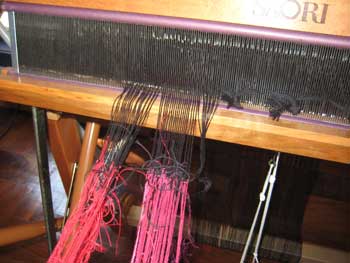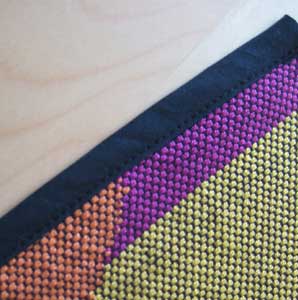 I haven’t done many dummy warps but my Saori loom presented a nice opportunity for its use last week. I’d come to the end of the original black warp and had dyed another cotton one to beam. Simply tying on the new warp on seemed so sensible to me. I didn’t use a weavers knot although this is possibly the best choice – I used an ordinary square knot.
I haven’t done many dummy warps but my Saori loom presented a nice opportunity for its use last week. I’d come to the end of the original black warp and had dyed another cotton one to beam. Simply tying on the new warp on seemed so sensible to me. I didn’t use a weavers knot although this is possibly the best choice – I used an ordinary square knot.
It had to be the secure square knot with no slippage. Don’t use the granny knot (see here), as it slips easily. The knot was a bit wasteful on the ends but it ensured the knots could be tied securely, and I trimmed some of the ends before beaming.
Weave blogger Peg shows a more comprehensive image of how the warp is attached. The cross sticks for the new warp must be maintained in a good position near the raddle to knot each thread in its turn. I am using the same sett for this warp as the previous one so it is a straightforward job.
 I opted for the dummy warp because it seemed easier in this situation where I just wanted to ‘replenish’ the warp for the type of freestyle weaving I do on this loom.
I opted for the dummy warp because it seemed easier in this situation where I just wanted to ‘replenish’ the warp for the type of freestyle weaving I do on this loom.
I don’t think that tying a dummy warp is necessarily a quicker way of warping either. But a better reason is to save on expensive yarn, like silk, which ends up being a weavers thrum – i.e. waste yarn. The necessary waste yarn at the end of a warp in weaving distresses me and a dummy warp is a good solution. However, I usually paint my warps along the entire length of the warp and then sell the handpainted short lengths of yarn on Ebay to embroiderers or other textile crafters.

My completed first Saori cloth using the clasped weft technique measured over four metres. I created two table runners and I’m so happy with them. I gave one to a friend and have the other on my table. It just brightens my day every time I look at it.
I finished off the ends by enclosing them in a black cotton bias which produced a neat finish especially when the cloth wasn’t a tight weave or could produce elegant fringing without adding a faux fringe.

Leave a Reply